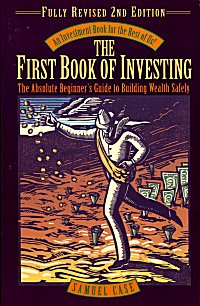Review: The First Book of Investing

- Title
- The First Book of Investing: The Absolute Beginner’s Guide to Building Wealth Safely: Second Edition
- Author
- Samuel Case
- Publisher
- Prima Publishing, Rocklin, CA, 1997
- ISBN
- 0-7615-0838-4
Review Copyright © 1999 Garret Wilson — January 23, 1999, 11:15am
The First Book of Investing is the book you need to start with before placing your money anywhere. Large type, friendly conversation, and lazy meanderings provide a relaxing introduction to investing that winds up covering everything from the stock market to real estate to rare coins. Samuel Case has provided an investing book for everyone.
Stocks are understandably the subject covered most extensively in the book. The basics are covered. A notable point: A corporation must first pay bond holders, then dividends of preferred stock holders, then those of common stock holders (202). The description of market orders and limit and stop orders are separated by explanations of real estate and socially-conscious investing, though. You may want to consider reading the book in the order of your choosing; if you want to concentrate on stocks, you might start with chapter 4, "The Stock Market" (41), and read a few chapters, then skip to chapter 18, "Going Further with Stocks" (201), and then after a few chapters skip to chapter 26, "Futures" (300) and chapter 27, "Options" (309). I, in fact, followed similar route, coming back to read about real estate and retirement just to say that I had.
Ignoring the mixed order of the chapters, the book is well-designed and laid out. Every few pages there is a little side-box giving more insight into a certain concept; see, for example, "The Rule of 70" to determine "how long it will take your money to double at any compound rate of interest." (85). Perhaps the most invaluable extra feature of the book is the "Resources" section at the end of each chapter, which lists places a reader may go for more information on a particular topic. Books, periodicals, cassettes, and seminars are all mentioned.
Another nice thing about the book is that is shows many real-world examples. In explaining mutual funds, for example, the return from an actual fund, Pax World Fund, is used as an illustration (76). Mutual funds are in fact explained quite well. I learned that open-ended mutual funds are one of the few investment options the prices of which are not directly derived from supply and demand. For a no-load open-ended mutual fund, someone could buy or sell a lot of shares, and the price per share would not change. The price would only change if the fund performed well or badly (69).
Closed-end mutual funds, on the other hand, do work on a supply/demand principle. As Case explains, closed-end country funds can drop suddenly if some large investor decides to pull his/her capital out of the fund because he/she has met his/her goals, because of reading an account, or because he "learned that his friend's Hyundai had just broken down" (149). This also illustrates the comfortable, lighthearted manner at which Case has when explaining things. The humor of, "Suppose you have it on good authority that Consolidated Bobsleds is about to go downhill fast" (206), for example, doesn’t really add to or take away from the explanation — they’re simply there once in a while to make you smile.
Case does inevitably leave a few places where improvement could make a more comprehensive guide. Credit Unions are mentioned, but the author doesn't explain exactly what they are or how they work (81). And when discussing socially responsible investing, the description of "soul-searching" (145) seemed superficial, almost ridiculously simple. How is lending money to the government for deficit spending (apparently assumed to be bad) that different than loaning money to a company for deficit spending?
On a historical note, one reason the crash of 1929 was so bad, Case explains, was that investors were allowed to borrow, for example, nine times the amount of capital they had -- $90,000 worth of stock could be had for only $10,000 worth of stock actually owned (210). Margin calls (209) then created a "deadly spiral." The Federal Reserve Board has since reduced limit on the amount you can borrow on margin, and this limit changes from time to time (211).
Samuel Case’s book is not really a textbook on investing, or a reference on finances. It is instead a great place to start. If you are wanting to start investing somewhere (anywhere), this book is likely to be what you need. Its relaxed style, solid coverage, wide spectrum of topics, and lists of resources means The First Book of Investing is just what it says it is.
Copyright © 1999 Garret Wilson